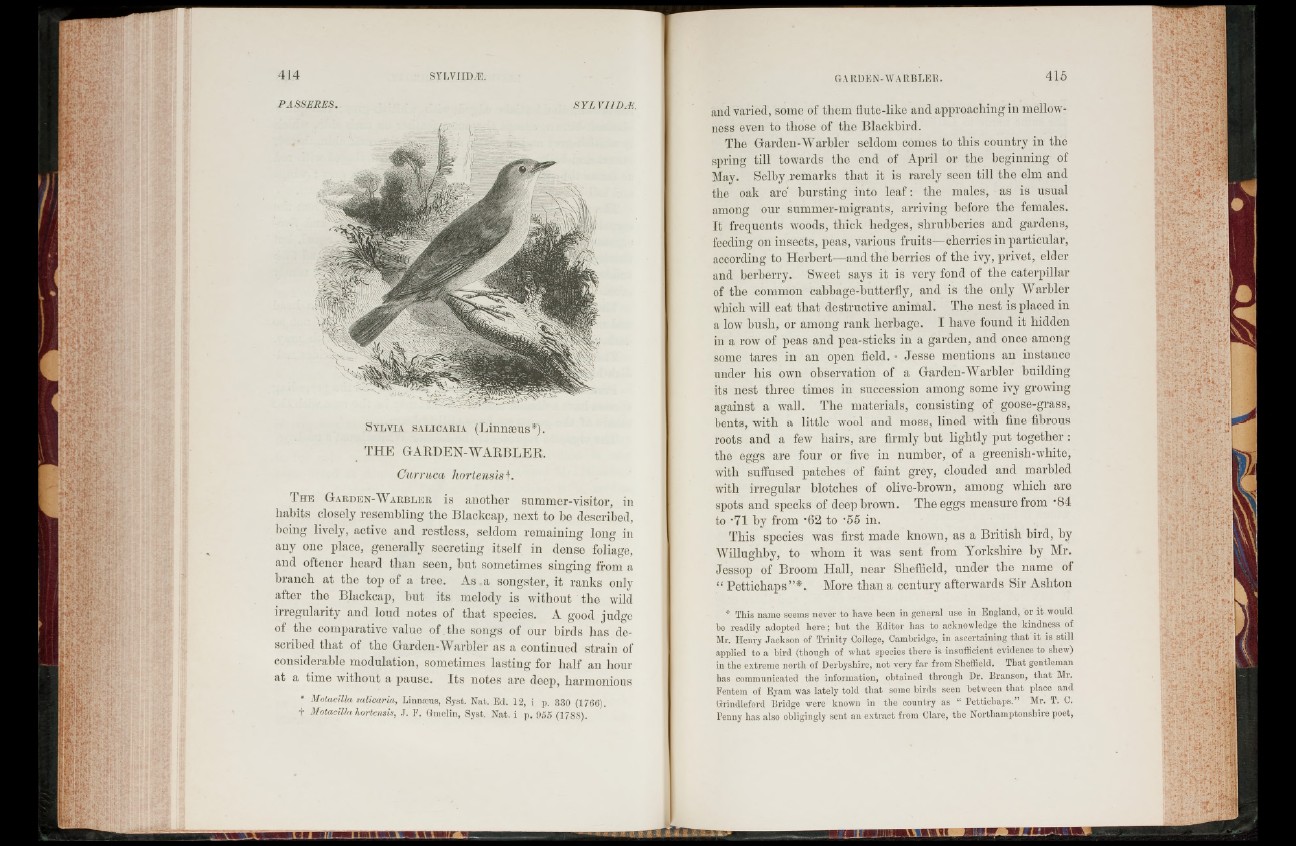
S y lv ia sa l ica k ia (Linnaeus*).
THE GARDEN-WARBLE R.
Curruca hortensis+.
T hf , G a rd k n -W a r b lk r is another summer-visitor, in
habits closely resembling the Blackcap, next to be described,
being lively, active and restless, seldom remaining long in
any one place, generally secreting itself in dense foliage,
and oftcner heard than seen, but sometimes singing from a
branch at (he top of a tree. As a songster, it ranks only
after the Blackcap, but its melody is without the wild
irregularity and loud notes of that species. A good judge
of the comparative value of the songs of our birds has described
that of the Garden-Warbler as a continued strain of
JK m P .I,- ’’ 'i considerable modulation, sometimes lasting for half an hour
at a time without a pause. Its notes are deep, harmonious
* Molacllla mlicaria, Linnaeus, Syst. Nat. Ed. 12, i p. 330 (1706).
t Motacillahortensis, .1. F. (imelin, Syst. Nat. i p. 955 (1788).
Ipjl « .
GA RDEN-W A UBLEl?. 415
a n d varied, some of them flute-like and approaching in mellowness
even to those of the Blackbird.
The Garden-Warbler seldom comes to this country in the
spring till towards the end of April or the beginning of
May. Selby remarks that it is rarely seen till the elm and
the oak are bursting into le a f: the males, as is usual
among our summer-migrants, arriving before the females.
It frequents woods, thick hedges, shrubberies and gardens,
feeding on insects, peas, various fruits—cherries in particular,
according to Herbert—and the berries of the ivy, privet, elder
and berberry. Sweet says it is very fond of the caterpillar
of the common cabbage-butterfly, and is the only Warbler
which will eat that destructive animal. The nest is placed in
a low bush, or among rank herbage. I have found it hidden
in a row of peas and pea-sticks in a garden, and once among
some tares in an open field. * Jesse mentions an instance
under his own observation of a Garden-Warbler building
its nest three times in succession among some ivy growing
against a wall. The materials, consisting of goose-grass,
bents, with a little wool and moss, lined with fine fibrous
roots and a few7 hairs, are firmly but lightly put together :
the eggs are four or five in number, of a greenish-white,
with suffused patches of faint grey, clouded and marbled
with irregular blotches of olive-brown, among which are
spots and specks of deep brown. The eggs measure from '84
to -71 by from ’62 to ’55 in.
This species was first made known, as a British hird, by
Willugliby, to whom it was sent from Yorkshire hy Mr.
Jessop of Broom Hall, near Sheffield, under the name of
“ Pettichaps More than a century afterwards Sir Ashton
* This name seems never to have been in general use in England, or it would
be readily adopted here; but the Editor has to acknowledge the kindness of
Mr. Henry Jackson of Trinity College, Cambridge, in ascertaining that it is still
applied to a bird (though of what species there is insufficient evidence to shew)
in the extreme north of Derbyshire, not very far from Sheffield. That gentleman
has communicated the information, obtained through Dr. Branson, that Mr.
Fentem of Eyam was lately told that some birds seen between that place and
Grrindleford Bridge were known in the country as “ Pettichaps. ’ Mr. T. C.
Penny has also obligingly sent an extract from Clare, the Northamptonshire poet,